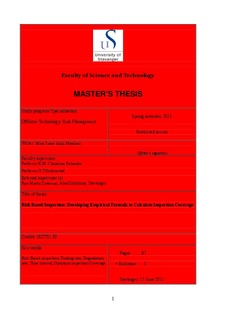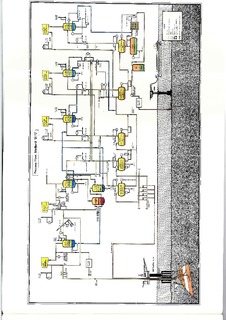| dc.contributor.author | Jalali Motahari, Mina Sadat | |
| dc.date.accessioned | 2013-06-20T12:58:57Z | |
| dc.date.available | 2013-06-20T12:58:57Z | |
| dc.date.issued | 2011 | |
| dc.identifier.citation | Conf.Until June 2013 | no_NO |
| dc.identifier.uri | http://hdl.handle.net/11250/183109 | |
| dc.description | Master's thesis in Offshore technology | no_NO |
| dc.description.abstract | The Risk Based Inspection (RBI) method prioritizes the process equipment, by calculating separate
likelihood and consequence values for each piece of equipment. The combination of likelihood and
consequence can be evaluated in a variety of ways to indicate critical equipment for action. Using
the tools of Risk Based Inspection, it has been confirmed that equipment can be operated safely for
a period of time, if inspections closely monitor the condition to eliminate uncertainties inherent in
predicting the damage rates such as corrosion and erosion. The developing RBI tools for the Oil and
Gas industries show promise as being effective and practical for decision making regarding
equipment inspection (Conley and Reynolds, 1997). A Risk-based inspection approach helps in
designing an alternative strategy to minimize the risk resulting from failures. Adapting a risk-based
maintenance strategy is essential in developing cost-effective maintenance policies (Bertolini et al.,
2009)
On the Norwegian Continental Shelf (NCS), some of the production and process facilities are
reaching to the end of their design life and need of inspection activities is more critical. Stricter
environmental and safety regulations and barriers coupled with increasing emphasis on cost
reductions have been forcing the industry to use development inspection techniques and materials
(Santos and Hajri, 2000). These returns to the questions: how much is the inspection coverage?
In this study, the Technical Condition (TC) of a sub-system in a production and process facility is
evaluated based on findings and historical data. Wall thicknesses of piping components inherently
decrease due to degradation mechanisms such as corrosion and erosion. The minimum wall
thickness is defined based on the standards and regulations. Based on the TC, reports are made for
future inspection purposes as well as to present to the asset owner (Operator Company). The report
recommends number of inspection that has to be carried out annually based on The TC.
Based on the remaining design life of the process facility, finding rate, criticality of the system,
materials specification changes, degradation rate, unexpected degradation behaviours and the
experience of the inspection planners, the thesis suggests an empirical model for inspection
coverage by using risk based inspection strategy and previous inspection data to be used on an aged
platform. The thesis also discusses about developing an inspection model as well as validating it
based on past inspection data (Santos and Hajri, 2000). | no_NO |
| dc.language.iso | eng | no_NO |
| dc.publisher | University of Stavanger, Norway | no_NO |
| dc.relation.ispartofseries | Masteroppgave/UIS-TN-IKM/2011; | |
| dc.subject | risk based inspection | no_NO |
| dc.subject | inspection coverage | no_NO |
| dc.subject | undervannsteknologi | no_NO |
| dc.subject | subsea technology | no_NO |
| dc.subject | offshore teknologi | no_NO |
| dc.title | Risk based inspection : developing empirical formula to calculate inspection coverage | no_NO |
| dc.type | Master thesis | no_NO |
| dc.subject.nsi | VDP::Technology: 500::Marine technology: 580 | no_NO |

